This post is about a dress form that has a fairly good method for approximating a woman's figure. Prior to discovering the "Uniquely You" dress form I tried another method that was quite the adventure.
My daughter loves to sew, but has a number of fitting challenges. A few years ago I bought the supplies to do a duct tape/liquid foam type of dress form. She put on a plastic garbage bag, and I wrapped her snugly in duct tape from neck to below the hip. (I have photos of this, but I am too kind to put them in this post). It was quite the process, and I feel claustrophobic just remembering encasing her in that tape! Anyway, the next step was to cut one side of the tape open so that she could escape that rig. Next we taped up the cut side, and then opened two cans of a liquid that is used in boats to give them buoyancy. It smelled foul, and it expanded at such a rate, and with such force that it pushed the cut side of the duct tape apart. There was much laughing and a little swearing as we tried to make that noxious stuff behave itself! Needless to say that wasn't a very satisfactory representation of my daughter's figure.
I had read about Uniquely You dress forms and I ordered one of these for my daughter for her birthday. This turned out to be MUCH more satisfactory.
 |
| Uniquely You Dress Form |
This is a neat system. A large box arrives, and in it is a foam "body" that has the biggest breasts you have ever seen, and an ample waist and hips also. There is a beige cotton cover that is used to firmly compress the foam into the desired shape. The company makes a range of foam form sizes and cotton covers to allow you to order a size closest to your measurements.The process for this transformation is written in a way that is sort of difficult to understand, and the art work looks like it was printed in 1955....anyway they could update and clarify their brochure.
This is a two person job. The person who is NOT having her body reproduced should know how to sew, and have some fitting skills. The cotton cover is zipped on, pin fitted, removed, sewed and zipped back on numerous times until the cotton cover is SO tight that it is as close to the body as possible.
The fitted fabric cover is now zipped over the foam greatly compressing the shape until it is a very, very close representation of the women's figure.( Having done this with about 6 women so far I know that you must be prepared for the hysteria that occurs while trying to wrangle this foam into it's straight jacket...many times strong husbands have to be summoned to help...can you imagine the looks on their faces...) The kit also comes with a metal floor stand.
Anyway, not only is it a great, dress form it also is a lot of fun to put together. The one I made for my daughter is in the photos. I marked the waist with a fabric pen to help her fit the garments she makes. She told me that it has made it much easier for her to sew for herself. Uniquely You dress forms can be ordered from various online vendors. They seem to vary in price but are in the $150 to 210.00 range.





















































